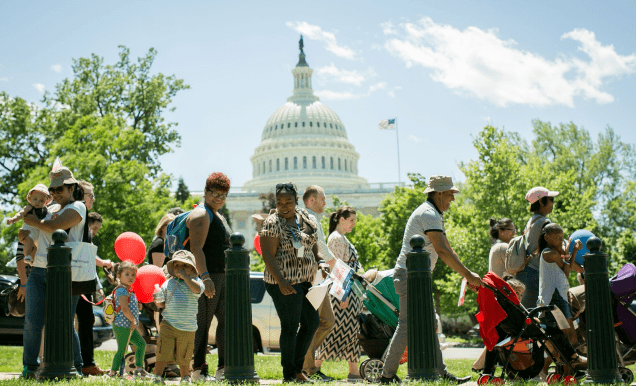10 Surprising Facts About Child Care in the United States
Approximately 14.4 million children under the age of 5 have all available parents in the workforce.
America’s child care crisis is a mounting challenge for countless parents across the nation, creating significant hurdles in daily life and long-term planning. With long waitlists, skyrocketing costs, and the pervasive issue of child care deserts—areas with few to no affordable child care options—families are often left scrambling to find reliable care.
These obstacles not only strain family budgets but also limit parents’ ability to work, pursue education, or balance their careers and personal lives. As the demand for quality child care continues to outstrip supply, the ripple effects are felt across communities, impacting the economy and the well-being of families nationwide.
Real Stories from Parents and Educators About the Child Care Crisis

Child Care Issue: Long Waitlists
Child care waitlists are a huge headache for many families. According to a 2022 survey by Child Care Aware of America, over half of parents are on waitlists for child care, sometimes waiting for a spot for a year or even longer. In busy cities, these wait times can stretch to two years or more.
The lack of accessible child care forces some parents to delay going back to their jobs after having a baby or settling for less ideal care.
We are currently on 8 waitlists and waiting to hear back from one lottery. Some waitlists we have been on for a year or two years. We are paying double compared to 5 years ago with my daughter. I work in public schools and almost had to take a year off but we found a place last-minute and they kindly offered to open 15 minutes early to accommodate us. It is crazy.
@madmandi, instagram

Child Care Issue: Affordability
Child care affordability is a major concern for many families. In most states, the average annual cost of infant care exceeds the average cost of in-state college tuition. For many families, especially those with multiple children, child care expenses can consume a significant portion of their income, often exceeding 20% of their household budget. This financial strain forces some parents to make tough decisions, such as cutting back on work hours, seeking cheaper but lower-quality care, or leaving the workforce altogether.
Why is child care so expensive?
I had to leave my pre-k teaching job because we couldn’t afford child care for a toddler and an infant when we expanded our family. Now I’m trying to return to the classroom and it’s next to impossible. We shouldn’t have to choose between career and family.
@katiewithak, instagram

Child Care Issue: Quality
Child care waitlists are a huge headache for many families. According to a 2022 survey by Child Care Aware of America, over half of parents are on waitlists for child care, sometimes waiting for a spot for a year or even longer. In busy cities, these wait times can stretch to two years or more.
The child care crisis forces some parents to delay going back to their jobs after having a baby or settling for less ideal care.
What are the elements of quality care?
My son is 2.5. He started daycare at 10 months old and has been in five, yes five, different daycares since. From distance and affordability to low quality care that ended with him in the hospital for an ER visit, finding the right daycare has been a stressful journey that I wish upon no parent. Happy to share more sometime. We absolutely love where he is now and the effort to find the right place was worth it!
@oliviagruwell, instagram

Child Care Issue: Workforce Training, Availability and Compensation
Early childhood education professionals face a myriad of challenges in their roles. They often work with limited resources and face high demands to meet diverse developmental needs of children. The profession is marked by low wages and limited job security, contributing to high turnover rates and difficulty in attracting and retaining qualified staff. Additionally, the emotional toll of providing care and education to young children, often from underserved or vulnerable populations, can lead to significant stress and burnout.
Navigating these challenges requires a strong support system, ongoing professional development, and policies that recognize and address the critical importance of early childhood education.
High quality early childhood programs can yield a $4 – $9 dollar return per $1 invested.
I am facing a lack of adequate training around babies with ASD. Also, I can’t afford to both buy groceries and pay my bills in full. I am so behind on my bills it is insane! And, I’m struggling to work with burnt out preschool teachers, all they do is yell at kids and remind them that they’re too old to cry. NO THEY AREN’T! It’s to the point I’m leaving the field next year when I finish my bachelors in social work.
@kaaat08, instagram
I was an early childhood center director for 4+ years, starting with COVID. It just hasn’t let up since. I don’t know how anyone can endure in this field. 😢
@ericachin5, instagram
The lack of inclusion programs in preschool that further isolates special needs children from their neurotypical peers is absolutely soul-crushing.
@sipdinedesign, instagram
Help us make affordable, high-quality child care with well-compensated and supported staff a reality for families across the country.
Read More

Next Up
Go to Next Resource
distillation
22 Statistics You Need to Know About Childhood Brain DevelopmentThe first three years of a child’s life are the most pivotal, and also the most vulnerable when it comes to childhood brain development.


